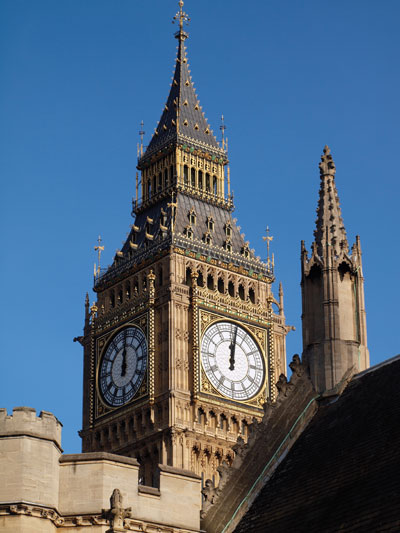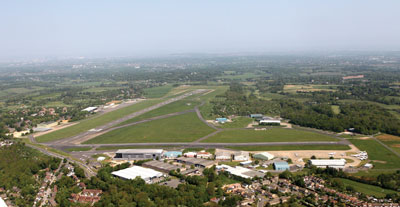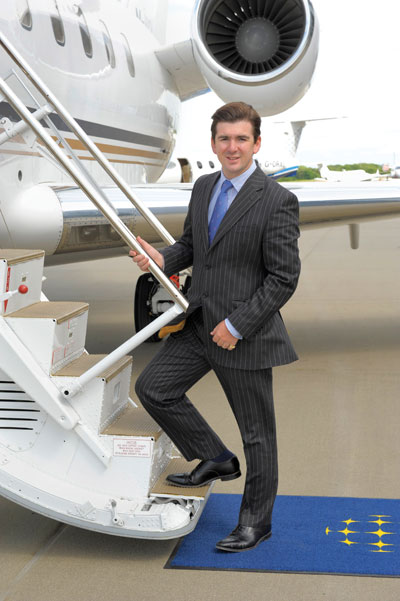
Features
Operations
An Olympic effort
By any stretch of the imagination, when you’re hosting the world’s largest sporting event, it certainly puts your BizAv infrastructure to the test.
May 9, 2012 By David Carr
By any stretch of the imagination, when you’re hosting the world’s largest sporting event, it certainly puts your BizAv infrastructure to the test.
 |
|
| Security in London will obviously be tight during the Olympic Games, especially over treasured sites such as Big Ben. Photo: Matt Nicholls
|
The Athens Olympics in 2004 lacked the necessary airport capacity. And the distance between Sydney 2000 and Beijing 2008 from the world’s major business aviation centres was too great for all but the longest-range private jets to complete nonstop. There are 38 airports (not including Heathrow and Gatwick) within 200 kilometres of the 2012 London Summer Olympics, including 13 tucked inside the coveted 50-kilometre gold ring. All are accessible from Europe and the North American east coast, making the British capital ready and geographically centred to accept the largest intake of private aircraft to attend the two-week summer sport spectacle July 27-Aug. 12.
Marquee events such as the Olympics, the Masters golf tournament and Super Bowl, are magnets for private jets. At Super Bowl XLVI in Indianapolis, for example, the U.S. Federal Aviation Administration (FAA) set up temporary towers to handle the volume of private airplanes flying out of nearby airports.
Manufacturers want in also. Bombardier, Dassault Falcon and Gulfstream routinely slip in ahead of the crush to bolster on-site technical support and show the flag. In London, Bombardier plans to have five field-service representatives and a mobile response team in close proximity to all airports. Additional support from the airframer’s customer service centre at Amsterdam’s Schiphol Airport will be a phone call away.
“Business aviation is attached to the largest corporations, who are also the event’s biggest sponsors,” said Sam Barone, president of the Canadian Business Aviation Association. “The principals travel with friends and associates who use the same type of transport.”
A bulge of business jets chasing sporting events is not uncommon in the U.K., which already has a strong global sports culture, including international cricket tournaments, Wimbledon and the British Open. Premier League Club owners, sponsors and their entourages often zip in for a regular football match. But hosting the Olympics is causing everybody to raise their game.
The U.K.’s Department for Transport (DfT) forecasts 3,000 inbound business jet movements over England’s crowded South East during the Olympic and Paralympic period. This is above the average 7,000 movements during the normal “quiet period” of July/August, with the lion’s share of traffic being split between four London area airports: Stansted, Biggin Hill, Luton and Cambridge. “That kind of increase in a six-week period is a material change,” said Glyn Jones, managing director for Luton Airport, the London area’s fourth biggest airport and the U.K.’s second busiest general aviation facility.
U.K. aviation authorities, airports and FBOs have spent years preparing for the Olympics, including taking cues from the World Cup in Johannesburg and 2010 Winter Olympics in Vancouver. Even so, every Olympics brings its own set of headaches. “These are massive undertakings and each one has a unique proposition in airspace planning, geography and, in Vancouver’s case, proximity to U.S. airspace,” said Barone. “London will be more magnified because it is a huge international city with different considerations.”
What London will have in common with Vancouver (other than trademark damp weather) will be added demand on FBOs. Vancouver International Airport experienced its busiest day in history after the closing ceremonies. During the Games, Landmark Aviation, Million Air and Avitat reported combined movements of almost 1,000 aircraft.
Jet Aviation London, based at Biggin Hill, one of the London area’s two dedicated business aviation airports, plans to hit the ground running. “We have handled Olympic events before,” said Judith Moreton, vice-president and general manager. Swiss-based Jet Aviation, a wholly owned subsidiary of General Dynamics, has a global network of 26 FBOs. At Biggin Hill, the company recently moved into a refurbished facility and will draw in Olympic-seasoned staff from around the world.
Catering is also a potential headache, given the convergence of so many diversified tastes crammed into two weeks. “We are not expecting it to be an issue,” Moreton said. “Aircraft caterers are used to being very specific. London is an international city and there are caterers who specialize in American-style catering or Middle East-style. They are just going to be a lot busier.”
 |
|
| Biggin Hill Airport is bracing for a large increase in BizAv traffic. Jet Aviation London is based at Biggin Hill, one of the London area’s two dedicated business aviation airports. The company recently moved into a refurbished facility and will draw in Olympic-seasoned staff from around the world. Photo: Biggin Hill Airport |
Dig below the weeds and the landscape becomes quite fluid. Except for the highest-profile events, such as opening and closing ceremonies (as in Vancouver, the day after the Olympic torch is extinguished (Aug. 13) will be the busiest day in British aviation), and the 100-metre final, aircraft arrivals are likely to follow the flow of the Games and whether a country is represented in the hunt for gold (nobody is anticipating a bump in flights from Canada for the soccer final). That means a lot of last-minute bookings, and likely a lot of disappointment in where you land.
“You can staff for a cloud of airplanes during the peaks,” said Robert Walters, business development manager for Biggin Hill. “Managing between the peaks is where the art will be. There will be a lot of wealthy people with business connections who hadn’t previously planned on coming. The longer they leave a booking, the less choice they have.”
Biggin Hill was the U.K.’s fastest-growing business aviation airport in 2011, with a 13.3 per cent increase in traffic, including a 30 per cent bump in high-end aircraft such as the Bombardier Challenger and Global, and Dassault Falcon 900. To accommodate increased traffic, the airport will turn a temporarily closed crosswind runway and abandoned third runway into parking.
Spare concrete is not the biggest challenge in the South East; manoeuvring around restricted airspace and slot availability will be. Major restrictions on London and the Olympic Park will run from July 14 to Aug. 15. The Prohibited Zone over the Olympic Park will be open only to commercial airliners using Heathrow, Gatwick, Stansted and London City. A smaller set of airspace restrictions will be in place for the Paralympic Games from Aug. 16 to Sept. 12. Restricted Zones over other Games’ events, such as the sailing at Weymouth/Portland, will only be in place for the duration of the event, although these are likely to disrupt access at nearby airports.
All slots at the 40 slot co-ordinated airports are being managed by Airport Coordination Limited, an independent company that allocates slots at 26 airports in the U.K. and Europe, including Heathrow and Gatwick. “It is important that you don’t make security restrictions so onerous that the traffic won’t come, but it’s not going to be business as usual over London airspace,” cautioned Barone. “There are several tiers of airspace restrictions and other demands. Our advice is book slots, get your operating permits and prepare checklists for complying with all their requirements.”
The Civil Aviation Authority has published an Aeronautical Information Circular detailing temporary routings and controlled airspace. NATS, the U.K.’s air navigation service provider, is anxious to prevent operators from dropping passengers off at a chosen airport and flying to a secondary airport to park. Known as internal repositioning, the practice gave the UN Copenhagen environmental summit a black eye in 2009. “You don’t want any part of that,” said Moreton. “It increases the air traffic problem, adds to the cost of operating and is not good for the environment.”
Still, corporate clients can be a demanding, influential bunch and internal repositioning could add up to 4,000 movements over the 31-day period.
 |
|
| Robert Walters, business development manager for Biggin Hill, says managing between the peaks will be the biggest challenge during the Games. Photo: Biggin Hill Airport |
Customers are also advised to do their research. London’s two dedicated business aviation airports, Biggin Hill and Farnborough, offer two different business models and have different operating profiles during the Olympics. Farnborough, which will also host its biannual international air show in July, has 24-hour access, a key consideration for somebody flying in for a single late-night event, given that hotel rooms are already sold out. Biggin Hill has restricted operating hours but larger ground capacity.
FBOs will also be a consideration. TAG is the exclusive FBO at Farnborough. Biggin Hill is able to serve more diverse segments of the market with three FBOs, including Jet Aviation and its own operation. Luton Airport also has three FBOs, Signature, Harrods and Ocean Skies, serving predominately North American, Middle East and Russian operators, respectively.
“You might not get a slot at your usual airport or FBO,” Barone points out. “But London has good second-tier airports such as Oxford, Cambridge and Cranfield (all within 100 kilometres of Olympic Park).”
Not everybody in the U.K. has put on their Olympic hat and airports have faced local resistance to service improvements for aviation clients. Surrounding residents overwhelmingly rejected Biggin Hill’s application to extend operating hours for the Games, and City Council blocked Luton’s plan to spend $6.4 million on a road widening intended to ease expected bottlenecks as limousines whisk clients from the airport to Olympic Park.
Although the network supporting business aviation in the South East may welcome the traffic blip the Olympics will deliver, this bump will likely bring year-over-year activity back to pre-recession traffic levels.
Nevertheless, hurt by recession and entering into the quiet summer period, the business aviation community in England’s South East will welcome the bump in traffic. With the global spotlight firmly on the U.K., the legacy will be what happens after the Olympians and Paralympians head home. “There is a real opportunity to introduce new customers to business aviation and bring back clients who stopped using business aviation because of the recession,” said Moreton.
Luton Airport, which in addition to high-end private jet activity is a hub for low-cost airlines such as easyjet (CAP J) and fast-growing, Budapest-based Wizz Air, plans to use the Olympics to showcase the airport as a convenient alternative to congested Heathrow and Gatwick by highlighting its user-friendly terminal building and ease of access to central London, including a direct rail link.
Luton posted nine per cent growth last year, more than doubling the U.K. average. And there is room for more. A short runway puts the airport out of reach of Canadian and U.S. operators, at least until the Boeing 787 is placed on more long-haul routes. Luton’s sights are fixed closer to home. “What we are expecting this summer is a pretty large number of passengers from central and Eastern Europe that used to be part of the Soviet Union,” said Jones. “That is our target, emerging markets that are not a part of the BRIC economies.”
Back at Biggin Hill, Walters agrees that the Olympics are an opportunity to showcase facilities to new customers and expand the base – that’s the long-term strategy. The immediate hurdle will be the Games themselves. “On the day,” he said, “we are all going to have to pedal much harder and faster, and keep on a smile.”
Aviation sites for Olympics info
|